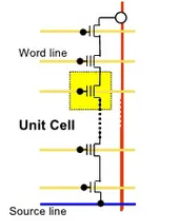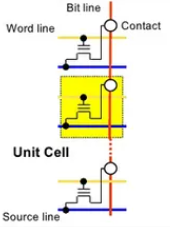
EEPROM vs. Flash: What are main differences between them?
December 21 2023 
Inquiry
Global electronic component supplier AMPHEO PTY LTD: Rich inventory for one-stop shopping. Inquire easily, and receive fast, customized solutions and quotes.
QUICK RFQ
ADD TO RFQ LIST
Electrical storage devices like EEPROM and Flash are both a part of ROM. Flash can store more data with a higher data density than EEPROM and has a simpler circuit. EEPROM is accessible per byte, while Flash is accessed by block. This article is going to talk about more differences between the EEPROM and Flash.
What is EEPROM?
The non-volatile memory known as EEPROM (electronically erasable programmable read-only memory) may be electrically written to and erased. It is used to store small amounts of information that must be kept even if power is lost, including calibration or system configuration settings. Since EEPROM can be erased and reprogrammed byte by byte, it is slower than flash memory but more adaptable. As opposed to other types of non-volatile memory, EEPROM can be erased and reprogrammed without the need for specialized equipment or erase cycles. As a result, EEPROMs can be used in applications that call for routine data updates, such as firmware upgrades.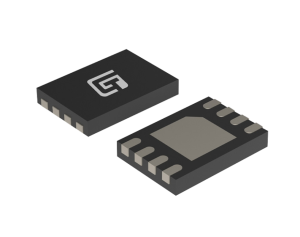
EEPROM vs EPROM
| EPROM | EEPROM |
| The content is removed from an EPROM using UV light. | In EEPROM, the electric signal is used to erase the data in the memory. |
| To delete and reprogram the system's BIOS, the EPROM chip must be severed from the circuit. | It is possible to do erase and reprogramming procedures without cutting off the system's electrical circuit. |
| The EPROM contains a rock crystal window. | The entire EEPROM is protected by an opaque plastic covering. |
| An EPROM cell's size is 1 in comparison. | Each cell in an EEPROM has a relative size of 3. |
| An EPROM wipe takes fifteen to twenty minutes to complete. | In EEPROM, an erase operation takes 5 milliseconds to complete. |
| An EPROM is a modified version of a PROM. | EEPROM is the EPROM's replacement in modern technology. |
| In EPROMs, hot electron injection programming is used. | EEPROM can be programmed using the tunnel effect. |
| After being deleted, EPROM memory can be reprogrammed. | EEPROM can also be reprogrammed after being erased, just as EPROM. |
| To function, the EPROM transistor needs 12.5 volts. | To function, the EEPROM transistor needs 5 volts. |
What is Flash Memory?
Non-volatile memory known as flash memory is used to store vast amounts of data, including the operating system for a tablet or smartphone. It is faster than EEPROM but less flexible because it can only be deleted and reprogrammed per block. Solid-state drives (SSDs), memory cards, and USB drives all utilize flash memory. Flash memory is a type of volatile memory that can only have huge blocks of data encoded and wiped. However, it appears that ONLY big block erasure-capable hardware uses AND flash. Flash memory has several uses. There are several features of flash memory. For solid-state storage, like static RAM, it is far less expensive than EEPROM and does not need batteries. Because flash is faster than EEPROM, it is frequently utilized in applications where speed is essential (such as digital cameras).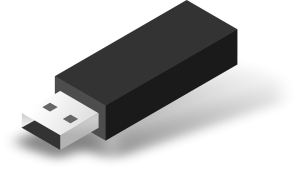
Flash Memory vs RAM
Non-volatile memory, such as flash memory, may store data without requiring continual power. DRAM and SRAM, the two most used types of RAM, are both volatile memory types that require continuous power to store data. Flash memory technology inspired the name of flash drives. Random access memory, or RAM, was created in 1967 as a superior replacement for cyclic access memory. RAM and flash memory both have an impact on how data is used and stored in today's gadgets. Random access memory, or RAM, is the common type of memory used in most computers. But to be more precise, DRAM, or dynamic random access memory, is the type of memory that is typically used by our computers. Later, we'll go into more detail. As long as RAM has an electrical power supply, it can store information as 1s and 0s.Flash Memory vs EEPROM
| Feature | EEPROM | Flash Memory |
| Erasure granularity | Byte-by-byte | Block-by-block |
| Density | Lower | Higher |
| Cost per bit | Higher | Lower |
| Endurance | Higher | Lower |
| Applications | Small data updates, frequent changes | Large data storage, frequent updates |
| Read/write performance | Faster byte-level access | Faster block-level access |
Video related to EEPROM vs Flash
EEPROM vs Flash Features
EEPROM Features- Protocol for bidirectional data transfer.
- Hardware data protection write protect pin.
- 16-byte pages (4K, 8K, 16K) and 8-byte pages (1K, 2K) compose modes.
- Automatic writing cycle.
- Organized internally 8-by-128 (1K), 8-by-256 (2K), 8-by-512 (4K), 8-by-1024 (8K), or 8-by-2048 (16K).
- Accessible automotive devices.
- Two wires read and write data into a two-wire serial interface.
- Low and standard voltage operation (compatible with 100 kHz (1.8V) and 400 kHz (2.7V, 5V)).
- Schmitt triggers with filtered inputs to reduce noise.
- High speed
- Low power consumption
- Reliability
- Relatively high read and write speeds
- Ensures high-speed read/write, data security, and stability while consuming a low power supply.
EEPROM Memory Types
| Serial EEPROM Memory | Parallel EEPROM Memory | ||
| Applications | Numerous industries, including telecom, consumer, automotive, and industrial, use EEPROMs. Other applications include data storage from a learn function akin to a remote control transmitter and reprogrammable calibration data for test equipment. | ||
| Serial vs. Parallel | Flash and EPROM devices can use parallel EEPROM chips. It has a faster and more dependable data transfer method than the serial EEPROM approach. It is bigger, denser, and more expensive because of the increased pin count. These factors increase the popularity of flash or serial EEPROMs over parallel EEPROMs. | ||
| EEPROM Meaning | This kind of chip, also known as an EEPROM, has fewer pins, which forces operations to be serialized, making it more challenging to operate. Due to the serial nature of the data transmission, this kind is slower than parallel units. There are several common interface types, including I2C over 1-Wire UNI/O over SPI. | These devices typically feature an 8-bit wide bus. The device usually incorporates pins to restrict writing and selection actions. Additionally, some microcontrollers can incorporate parallel EEPROM for software storage. The chip operates more swiftly and simply than serial devices. The larger size of this type, which results from more pins, is a disadvantage. | |
| Features |
|
|
|
Types of Flash Memory
| NOR Flash Explained | NAND Flash Explained | |
| Flash Memory Definition | NOR Electronic gadgets use Flash Memory, a form of Non-Volatile Memory (NVM), to store data. Since the first decade of the 1990s, it has been widely utilized and often takes the form of integrated circuits. | A non-volatile storage technology called NAND Flash can store data without the need for power. An everyday example would be a mobile phone, where data files like images, videos, and music are kept on a microSD card and saved on the NAND Flash (also known as the memory chip). |
| Cell Array |
|
|
| Cell Size | 4F2 | 10F2 |
| Layout |
|
|
| Cross-section |
|
|
| Applications | Mobile phones, scientific equipment, and medical gadgets including MP3 players, digital cameras, and USB (Universal Serial Bus) flash drives are the most common applications for NOR flash. NAND and NOR flash are both used by some devices. | Devices, where enormous files are often uploaded and changed, have found a market for NAND storage. NAND technology is used in USB flash drives, digital cameras, and MP3 players. |
How does EEPROM Memory work?
Both EEPROM and UV-EPROM are based on the same principle. The trapped electrons in the floating gate will change the characteristics of the cell, causing it to store a logic "0" or "1" instead of a logic "0." EEPROM is the memory type that employs the least number of standards for cell design. Two transistors are found in the majority of cells. In this case, the electrons will be captured by the floating gate on the memory transistor. There is also a usable access transistor available. Unlike an EPROM, which erases the cell when the electrons are released from the floating gate, an EEPROM deletes the cell when the electrons are locked in the floating cell.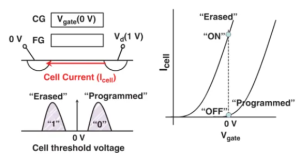
How does Flash Memory work?
A floating gate MOS tube (MOSFET) is the fundamental unit of flash memory. The floating gate can store charge, changing the control gate's switching threshold level. When a positive charge or electron is present in the floating gate, the word "1" is displayed, while a negative charge or electron is present, the word "0" is displayed.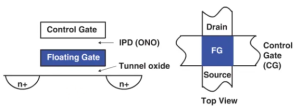
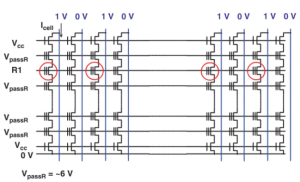
Pros and cons of EEPROM vs Flash
| EEPROM | Flash | |
| Pros | The integrity of non-volatile EEPROM data is maintained even after the power is turned off. | There are no revolving parts in flash memory. It just depends on electrochemical processes. Its physical toughness is also increased by the absence of moving parts. |
| Data can be wiped quickly since it employs electrical signals and offers the option of erasing the full contents or a specific byte. | Flash memory is typically offered in a variety of form factors to accommodate a variety of needs. It is very versatile since more or equal capacity may be crammed into smaller components. | |
| EEPROM electronically wipes content in 5–10 ms instead of EPROM, which uses UV signals and erases memory in minutes. | With a transfer speed of around 4.8 GB per second nowadays, flash memory devices outperform all other storage technologies. | |
| You may easily reprogram EEPROM without removing it from the computer or requiring any additional tools. | Flash memory is superior despite hard disk drives improving dependability. This is due to the absence of any moving parts. | |
| Cons | Different voltages must be used to read, write, and erase the material. | The majority of flash memory devices, if not all of them, are unable to reach capacities that are equal to those of hard disc drives. |
| The employed insulator is not a perfect insulator, and the manufacturer only provides a ten-year data retention warranty, which causes data retention problems. | The fact that flash memory rewrites data in block units is another drawback. Every byte must always be handled individually, which could take some time. When editing directly on flash-stored files, this significantly slows down the editing process. |
EEPROM vs Flash Applications
EEPROM Applications
- An EEPROM is usually used as a fixed section of memory that holds specific data.
- In the computer field, EEPROMs can store BIOS configuration files, programs for USB keyboards and mice, firmware information, and more.
- In other fields, EEPROMs can be used for control systems or configuration settings for embedded devices, including temperature sensors and automotive engine control units.
Flash Applications
- To offer dependable and stable data storage solutions, devices like USB flash drives, SSD hard drives, digital cameras, smartphones, etc.
- Embedded and industrial applications, including those for self-driving cars, smart homes, medical equipment, etc., can also make use of flash memory.
Conclusion of EEPROM vs Flash
In reality, many products that quickly modify the data stored on the chip cannot employ EEPROM chips because of their sluggish read/write speeds. Flash memory, a type of EEPROM that employs in-circuit wiring to erase by applying an electrical field to the entire chip or to preset parts of the chip called blocks, was created by manufacturers as a solution to this problem. Flash memory writes data in chunks, typically 512 bytes in size, rather than one byte at a time, making it work much more quickly than conventional EEPROMs. Both EEPROM and Flash are types of electrical storage that are part of ROM. Compared to EEPROM, Flash has a simpler circuit and can store more data with a greater data density. Flash is accessed by block, whereas EEPROM is accessed by byte; EEPROM can be erased more frequently than FLASH; EEPROM is more erasable than FLASH; EEPROM costs more per unit of capacity than FLASH; EEPROM typically has a small capacity; EEPROM is typically used to store data that won't be lost when the program is running to power down, whereas FLASH is typically used to store the program.EEPROM vs Flash FAQ
EEPROM vs Flash
FLASH cannot be erased as frequently as EEPROM. In addition to costing more per unit of storage than FLASH, EEPROM is more erasable than FLASH. In contrast to FLASH, which is often used to store programs, EEPROM typically has a tiny capacity and is used to store data that won't be lost when the program is going to shut off.Why is flash memory considered nonvolatile?
Flash storage makes use of flash memory, a kind of nonvolatile memory. Even if your power goes out, you won't lose your data since nonvolatile memory doesn't need power to retain the integrity of recorded data. In other words, when the disk is turned off, nonvolatile memory won't "forget" the data it has saved.Why choose EEPROM instead of Flash?
The lifespan capacity of an EEPROM is one million erase/rewrite cycles. Depending on the type of Flash memory, Flash devices have a limited lifespan; most Flash products can withstand 10,000–1,000,000 erase/write cycles before damage begins to jeopardize the integrity of the storage.What are the pros and cons of EEPROM and Flash?
Even after the power is turned off, non-volatile EEPROM data is kept intact. Flash memory is devoid of rotating components. Just electrochemical processes determine it. The lack of moving parts also increases its physical toughness. While different voltages must be used to read, write, and erase data in EEPROM, the majority, if not all, of flash memory devices are unable to achieve capacities comparable to that of hard disk drives.What are the disadvantages of Flash?
Most flash memory units, if not all of them, are unable to achieve capacities comparable to hard disc drives. Another disadvantage is that flash memory rewrites data in block units. Always handle each byte independently, which may take some time. This drastically slows down editing when done directly on flash-stored files.What are the disadvantages of EEPROM?
Different voltages must be applied to read, write, and delete the data in EEPROM. Data retention issues arise because the manufacturer only offers a ten-year data retention warranty and the used insulator is not a perfect insulator.Related Articles
Populer Posts

